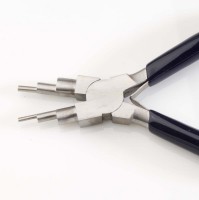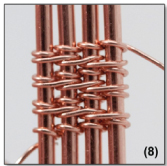- NEW DVD Series – Stone Setting with Bezels
- Tube Set Charm by Kim St. Jean
- Prong Basket Pendant by Kim St. Jean
- NEW DVD Series – Stone Setting with Cold Connections
- New DVD Series – Stone Setting with Wire
- NEW DVD Series: Introduction to Stone Setting by Kim St. Jean
- Featured Tool: Bracelet Bending Plier
- NEW Dvd by Eva Sherman
- Fun, Fast Fold Forming DVD Series
- Double Band Ear Cuff from Alex Simkin
Daily Wire Tip May 21: When to Use 4 1/2″ Flat Nose Prong Making Pliers
Daily Wire Jewelry Making Tip
May 21, 2010
Question:
I recently bought a pair of 4 1/2 Inch Flat Nose Prong Making Pliers 1mm and would like to know how to use them. I can’t seem to find any information on them.
Answer:
The 4 ½-inch measurement is the length of the tool, while the 1mm is the distance across the very end of the tip. The idea behind this tool is to use the 1mm tip to measure the length of, and then make the 90-degree bends on, the wire prong being created to hold a cut stone within a wire design.
Due to the fact that the necessary lengths of prongs are determined by the size of the stone being set, there are several different sized ‘prong making’ pliers available. Larger stones need prongs longer than 1mm, so if one were to purchase all of the sized pliers available they would have a choice.
Personally, I like to keep life simple and use a pair of chain nose pliers, marking my choice of prong lengths along its’ side, creating one tool that can be used to make as many different prong lengths as I desire, at any given time.
Answer contributed by Dale “Cougar” Armstrong
Have a question? Submit your question here























Robert Kelly
May 21, 2010 at 9:50 am
While some of the tips are helpful. It would be more helpful if you included PHOTO’s (1 or 2) to most of them to SHOW how its done. Explanations are good, but there’s nothing quite like SEEING it to get your point across.
dalecgr
May 21, 2010 at 7:06 pm
Robert, follow this link and scroll down a little bit to see 3 samples of prong pliers: http://www.wire-sculpture.com/jewelry-pliers-1.html
Sue Parish
May 24, 2010 at 12:42 pm
As an instructor, teaching wire wrapping I use the multiple prong pliers sold on this website and use your website as a reference source in my syllabus. The prong pliers offerred on this website, with the different sizes makes prong making so much easier for the beginner to the advanced wire artist. I might take this moment to point out that teaching the beginner to use these prong pliers aids them in producing much cleaner, successful turns than using the chain nose. So often the chain nose pliers in the hands of a newbie results in unsightly marring of the wire and potential breaking at a key turn. So many new wire artists fret about the tool marks on their work so these help to take just one frustration out of the equation.
As Dale points out, the size of the stone is key in the consideration of what size prongs you will be needing to create for your work. I use the 1.5 mm pliers the most often because I do so many medium sized stones. When I am presented with a thick,or large stone then I may use the 2.0 mm pliers. My 1.0 mm pliers are often reserved for making prongs with smaller and thinner stones or cameos. They make a delicate turn for a less obtrusive bracket, or prong on the finer pieces you produce.
I agree that a demonstration video of how these marvelous pliers are used would be very valuable to everyone!!! Thanks for getting this information out.
Suz
dalecgr
May 24, 2010 at 9:40 pm
Thanks so much for your input Sue – personally I reserve basic prong designs for intermediate students and serious prong designs (such as a prong ring) for advanced students, because I prefer that the student have really good tool skills before working a technique that is not as forgiving as most, so they are not as discouraged. Kudos to you!